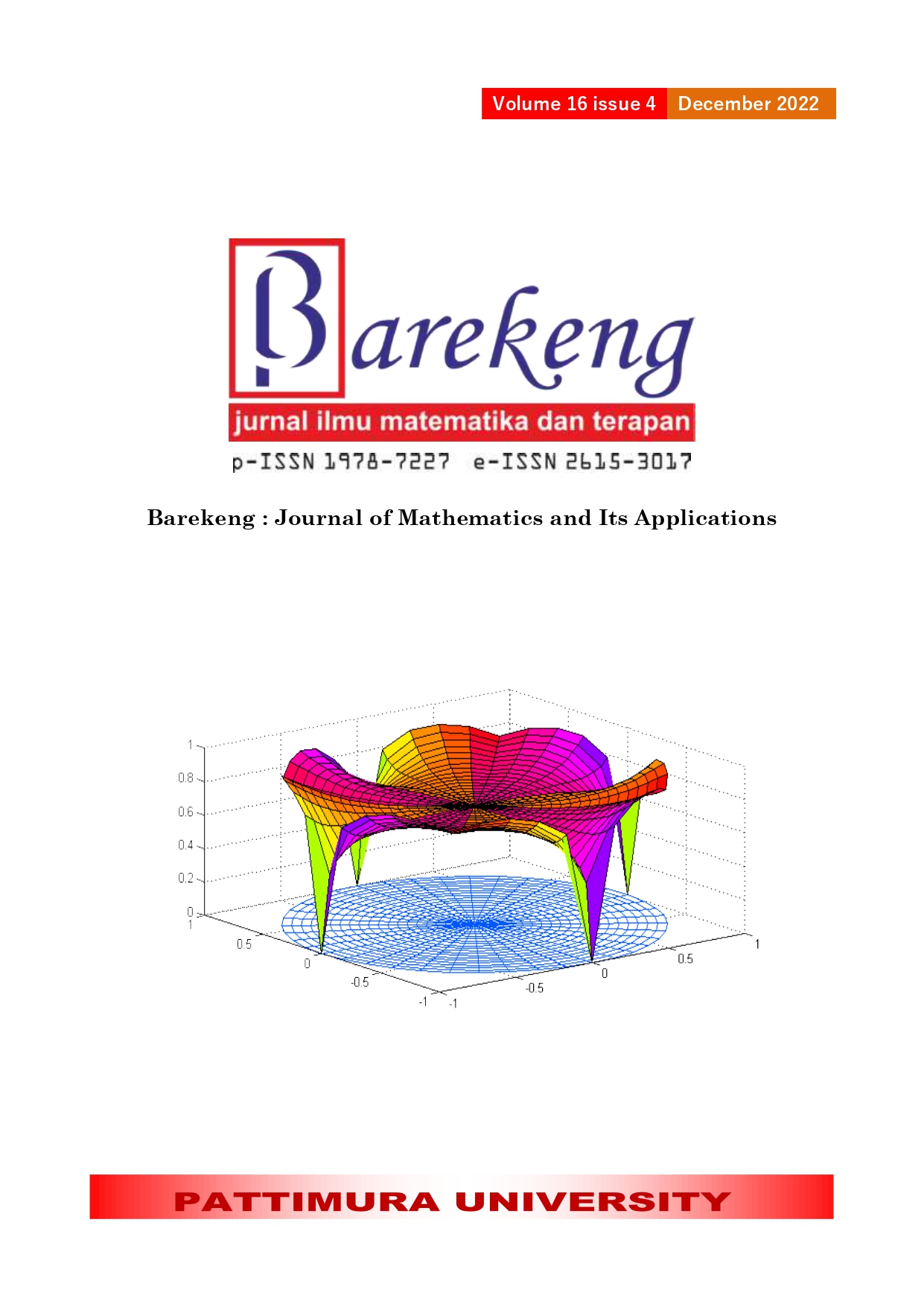COMPARISON IN PREDICTING THE SHORT-TERM USING THE SARIMA, DSARIMA AND TSARIMA METHODS
Abstract
The flow of data and information is growing rapidly and rapidly in various sizes and means which is called Big Data. In the face of a change for the better in the future, a careful analysis and design of a data processing system is needed, in which a predictive framework can formulate the right policy to be one of the efforts to make a good decision. This is one of the appropriate Big Data processing efforts, which can be realized through one of the methods, namely prediction or forecasting is an effort to predict future values or trends as a reference for analyzing conditions in the past. One example of Big Data in the City of Balikpapan, namely the temperature within 2 meters obtained from the NASA satellite published on the website power.larc.nasa.gov. One of the methods used in this research is the ARIMA method and it is developed according to the data used. Based on the data to be used, namely temperature data within a distance of 2 meters in the city of Balikpapan, the development of data processing is carried out to pay attention to three seasonal patterns or the so-called Triple Seasonal ARIMA model. In this study, it can be seen how to build the Triple Seasonal ARIMA model and comparison with alternative models, namely Seasonal ARIMA and Double Seasonal ARIMA, and can see how the results of the Triple Seasonal ARIMA model accuracy when compared with alternative models. The method used in this study is the Seasonal ARIMA, Double Seasonal ARIMA and Triple Seasonal ARIMA methods. The results obtained in this study obtained a comparison of methods in making predictions with a specified time span, the results obtained from the Seasonal ARIMA model that it was very good at predicting a time span of 2 weeks, Double Seasonal ARIMA for a period of 1 month, Double Seasonal ARIMA for a period of 3 months, and Triple Seasonal ARIMA for a period of 6 months.
Downloads
References
A. P. Natasuwarna. (2018), Prediksi Pengaruh Medsos terhadap Pilihan Mahasiswa pada Pilkada Serentak Menggunakan Data Mining, Sensitek, 12, July, 2018. Vol.1, No. 1, pp. 98-103.
Ali, I. (2015). Big Data: Apa dan pengaruhnya pada perpustakaan?(What is Big Data and its Influence to Library). Media Pustakawan, 22(4), 15-19.
Aswi Dan Sukarna. (2006). Analisis Deret Waktu: Teori Dan Aplikasi. Makasar: Andira Publisher.
Azka, M., Wiradinata, S. A., & Faisal, M. (2020, May). Double Seasonal ARIMA for Forecasting Electricity Demand of Kuaro Main Gate in East Kalimantan. In IOP Conference Series: Materials Science and Engineering (Vol. 846, No. 1, p. 012064). IOP Publishing.
Bowerman, Bruce L. And O'connell Richard T. Forecasting And Time Series: An Applied Approach, Third Edition. Duxbury Press, 1993.
Elvierayani, R. R. (2017), “Prediksi Nilai Tukar (Kurs) Rupiah Terhadap Dolar Tahun 2017 dengan Menggunakan Metode Arima Box-Jenkins”, 254.
Fitria, I., Handayati, K. N., & Hasanah, P. (2021, March). The application of Geometric Brownian Motion in stock forecasting during the coronavirus outbreak in Indonesia. In Journal of Physics: Conference Series (Vol. 1821, No. 1, p. 012008). IOP Publishing.
Katabba, Y. I. (2021). “Metode Seasonal Autoregressive Integrated Moving Average (SARIMA) Untuk Memprediksi Jumlah Penumpang Kereta Api Di Pulau Sumatera”.
Ningrum, K. P. (2021), Prediksi nilai impor alat telekomunikasi dan elektronik indonesia menggunkan model ARIMA-GARCH.
Susanti, L., Hasanah, P., & Winarni, W. (2020). Peramalan Suhu Udara dan Dampaknya terhadap Konsumsi Energi Listrik di Kalimantan Timur. BAREKENG: Jurnal Ilmu Matematika dan Terapan, 14(3), 399-412.
Sugiarsono, J. (2015). SWA sembada Media Bisnis.
Suyanto. (2017), “Data Mining untuk Klasifikasi dan Klasterisasi Data”, Informatika.
Dinata, S. A. W., Azka, M., Hasanah, P., Suhartono, S., & Gamal, M. D. H. (2021). Comparison of Short-Term Load Forecasting Based on Kalimantan Data. Indonesian Journal of Statistics and Its Applications, 5(2), 243-259.
Vuzi Fandiyah, Laylil. (2020), Peramalan Penjualan Beras Pada Ud. Elang Perkasa Ponorogo Sebagai Dasar Penyusunan Anggaran Komprehensif Tahun 2020. Skripsi (S1) thesis, Universitas Muhammadiyah Ponorogo.
W. W. S. Wei. (2006), Time Series Analysis Univariate and Multivariate Methods. SECOND EDITION. 2006.
Wibowo, H., Mulyadi, Y., & Abdullah, A. G. (2012). “Peramalan Beban Listrik Jangka Pendek Terklasifikasi Berbasis Metode Autoregressive Integrated Moving Average”. Electrans, 11(2), 44–50
Y.S. Nugroho. (2014), “Data Mining Menggunakan Algoritma Naive Bayes Untuk Klasifikasi Kelulusan Mahasiswa Universitas Dian Nuswantoro”, Dian Nuswantoro Fakultas Ilmu Komputer, November.
Copyright (c) 2022 Muhammad Giovani, Indira Anggriani, Syalam Ali Wira Dinata Simatupang

This work is licensed under a Creative Commons Attribution-ShareAlike 4.0 International License.
Authors who publish with this Journal agree to the following terms:
- Author retain copyright and grant the journal right of first publication with the work simultaneously licensed under a creative commons attribution license that allow others to share the work within an acknowledgement of the work’s authorship and initial publication of this journal.
- Authors are able to enter into separate, additional contractual arrangement for the non-exclusive distribution of the journal’s published version of the work (e.g. acknowledgement of its initial publication in this journal).
- Authors are permitted and encouraged to post their work online (e.g. in institutional repositories or on their websites) prior to and during the submission process, as it can lead to productive exchanges, as well as earlier and greater citation of published works.






1.gif)



